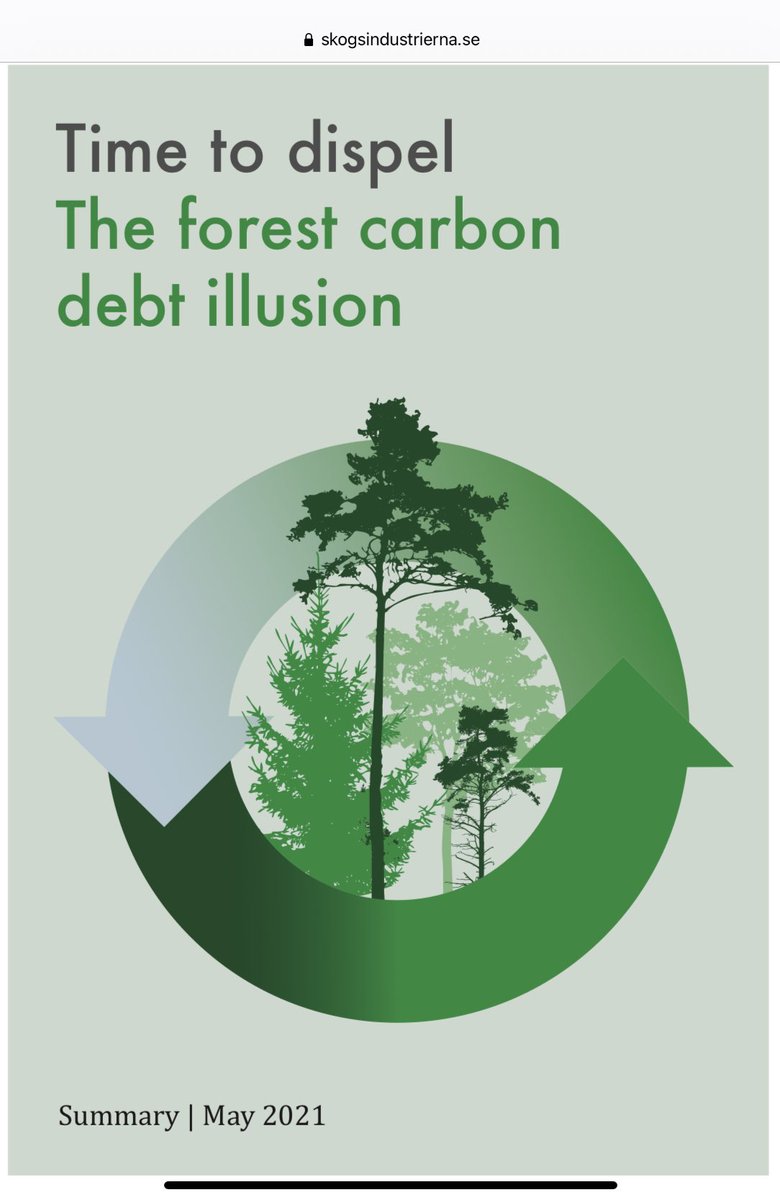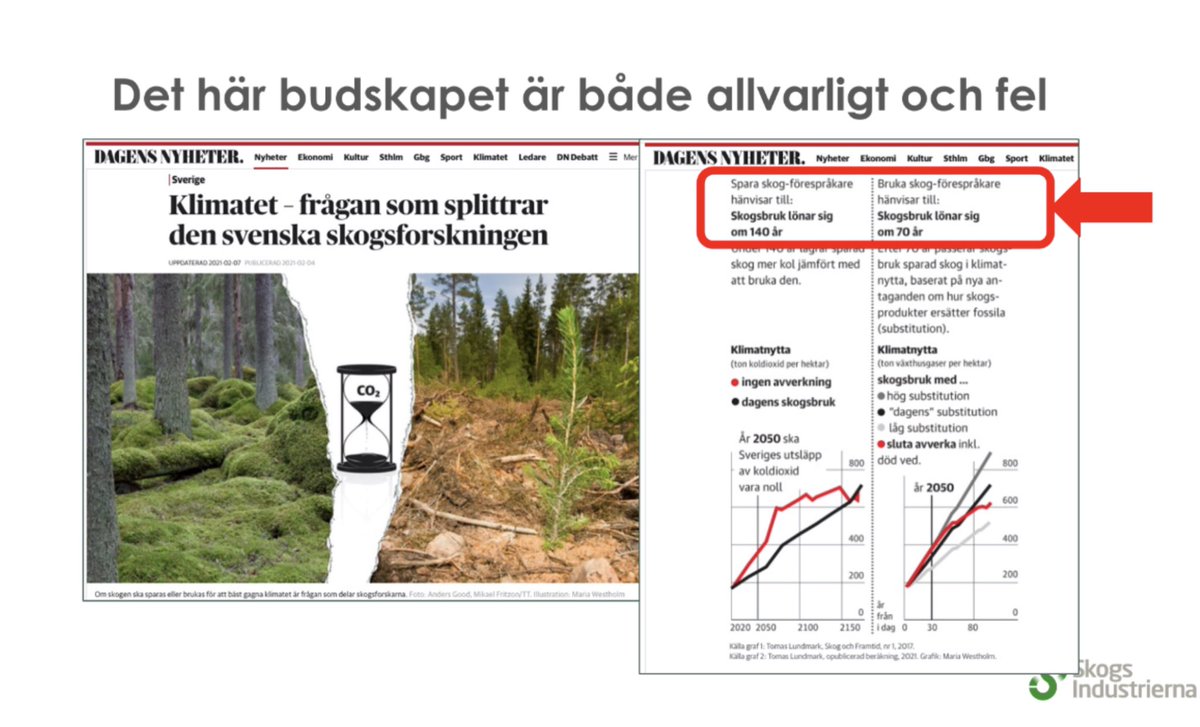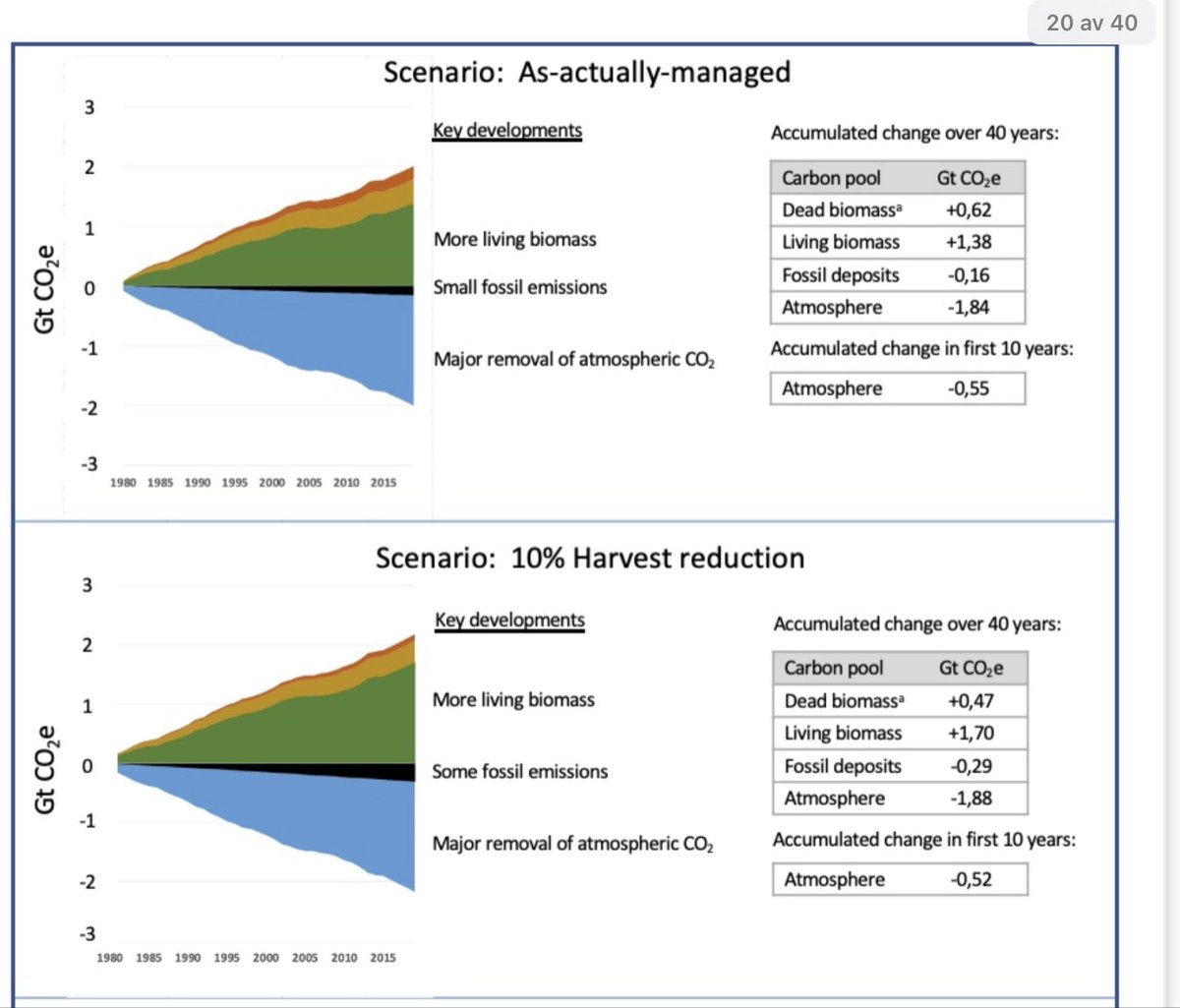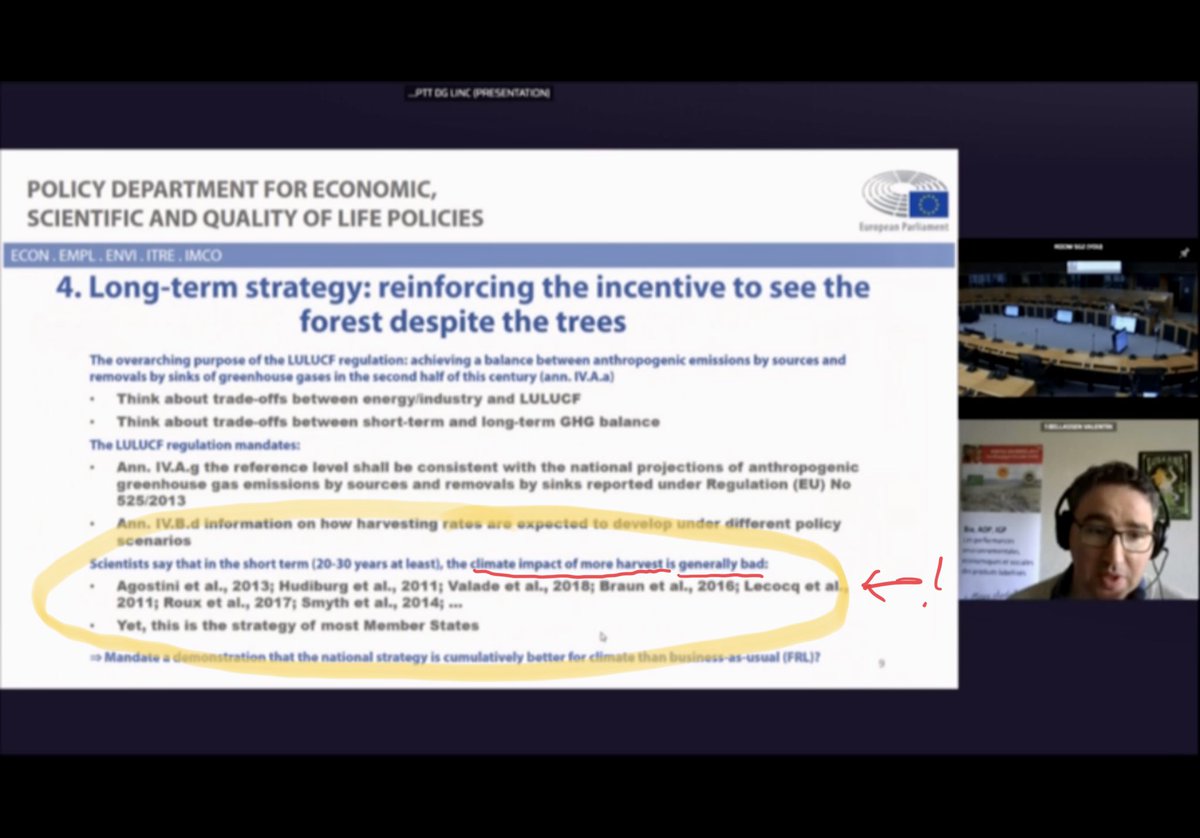
The Swedish forestry industry @Skogsindustrin have this week published a new report by @pholmgren arguing that cutting down more trees is good for the climate.
This is counterintuitive, but is it true?
Let´s do a proper THREAD on ”forest industry math” 🌲 🌲 🌲 🌲
👇
1/26
This is counterintuitive, but is it true?
Let´s do a proper THREAD on ”forest industry math” 🌲 🌲 🌲 🌲
👇
1/26

First cred to @JesperStarn @bloomberg who came up with the nice description "forest industry math" in describing the piece in the news - a good phrase to capture the ”creative accounting” going on. This has been shared with great enthusiasm. 2/26
bloomberg.com/news/articles/…
bloomberg.com/news/articles/…
The research on climate impact of forestry has improved tremendously in the last decade. Concepts such as ”carbon parity/payback time” now describe dynamics taking into account what happens to carbon in forests, products and substitution (e.g. displacing fossils).
🌲💫🌥🌲 3/26
🌲💫🌥🌲 3/26
The report argues that it dispels a "carbon debt" myth and disqualifies much current research. However, the ”takedown” is hard to take seriously. 😳
Carbon debt has not been THE key popular/scientific concept for managed forests during the last decade for managed forests.
4/26
Carbon debt has not been THE key popular/scientific concept for managed forests during the last decade for managed forests.
4/26
Many of the papers and media hits cited/critiqued do not focus on carbon debt or argues against it´s use.
Now the report tries to kill two birds with one stone by conflating ”carbon debt/carbon parity”.
This leads to ”carbon debt confusion” (on p.6) (skogsindustrierna.se/siteassets/dok…) 5/26
Now the report tries to kill two birds with one stone by conflating ”carbon debt/carbon parity”.
This leads to ”carbon debt confusion” (on p.6) (skogsindustrierna.se/siteassets/dok…) 5/26

Instead of dispelling a myth, this critique of the uses of ”carbon debt” and the extension of the critique to all concepts showing the climate footprint of forestry should be taken for what it is: essentially a constructed straw-man argument. fallacyinlogic.com/straw-man-argu…
6/26
6/26
One example.
The report and the presentation at the publication of the report aims to be critical of reporting on forestry in @dagensnyheter , but the newspaper clearly focuses on the ”carbon payback/parity”, and does not use the ”toxic” concept of ”carbon debt”.
7/26
The report and the presentation at the publication of the report aims to be critical of reporting on forestry in @dagensnyheter , but the newspaper clearly focuses on the ”carbon payback/parity”, and does not use the ”toxic” concept of ”carbon debt”.
7/26

Now, where does this analysis take us?
The central claim of the report is that BAU forestry is best for climate (=net emissions) even in the short term, compared to reducing logging slightly or alot.
(Image on p. 19)
How does this hold up against other research ?
🧐🧐
8/26
The central claim of the report is that BAU forestry is best for climate (=net emissions) even in the short term, compared to reducing logging slightly or alot.
(Image on p. 19)
How does this hold up against other research ?
🧐🧐
8/26

The problem: this argument is countered by so many recent papers and just has no support.
Here´s one recent paper that shows that there is a clear trade-off between logging and net emissions in Nordic conditions on timescales of some decades.
9/26
link.springer.com/article/10.100…
Here´s one recent paper that shows that there is a clear trade-off between logging and net emissions in Nordic conditions on timescales of some decades.
9/26
link.springer.com/article/10.100…
here´s the overview slide from INRA researcher Valentin Belassen in the European parliament hearing last week, citing the +5 other major publications on this topic
👉
more logging = more net emissions (in 2-3 decades at least).
And still this is the dominant strategy!
10/26
👉
more logging = more net emissions (in 2-3 decades at least).
And still this is the dominant strategy!
10/26

So the results go against conventional wisdom and basically all existing studies.
How is the report and ”forest industry math” able to support the conclusion of more logging being better than less logging even in the short term?
This is where it gets interesting!
11/26
How is the report and ”forest industry math” able to support the conclusion of more logging being better than less logging even in the short term?
This is where it gets interesting!
11/26
First example:
* by assuming that a moderate decrease of 10 % in logging rates would increase natural losses by a whopping 30 % (!)
(see caption below and p. 15)
No justification for this big increase of losses given, but this alone is enough to alter conclusions!
12/26
* by assuming that a moderate decrease of 10 % in logging rates would increase natural losses by a whopping 30 % (!)
(see caption below and p. 15)
No justification for this big increase of losses given, but this alone is enough to alter conclusions!
12/26

Secondly, soil carbon (p.12) was excluded, thru argument:
it would only strenghen the performance of scenarios with more logging. Another erroneous argument (or sink/stock confusion?). Total carbon stock in soils would be larger with less logging.
13/26
onlinelibrary.wiley.com/doi/abs/10.111…
it would only strenghen the performance of scenarios with more logging. Another erroneous argument (or sink/stock confusion?). Total carbon stock in soils would be larger with less logging.
13/26
onlinelibrary.wiley.com/doi/abs/10.111…
Thirdly, let´s look at the decaying of stumps and residues left in the forest.
The report argues that they rely on rates by Melin et al 2009. But chose ”a somewhat higher pace”.
Guess what ”somewhat higher” means in ”forest industry math”?
That´s 35-40 % higher.
14/26
The report argues that they rely on rates by Melin et al 2009. But chose ”a somewhat higher pace”.
Guess what ”somewhat higher” means in ”forest industry math”?
That´s 35-40 % higher.
14/26
Bare with me here! Now it so happens, that even that even the paper by Melin et al 2009 assumes very fast decaying.
As argued by @RepoAnna and others the decay is probably considerably slower than Melin et al argues due to methodological reasons. onlinelibrary.wiley.com/doi/full/10.11…
15/26
As argued by @RepoAnna and others the decay is probably considerably slower than Melin et al argues due to methodological reasons. onlinelibrary.wiley.com/doi/full/10.11…
15/26
This matters: w/o proper modelling of dead wood / soils we can´t even begin to compare BAU to ”leave alone” forestry.
Does ”forestry industry math” involve taking one of the fastest decay estimate out there and guesstimating a parameter of further +35 % quicker decay?
16/26
Does ”forestry industry math” involve taking one of the fastest decay estimate out there and guesstimating a parameter of further +35 % quicker decay?
16/26
I could go on, but you see the pattern.
This report and it´s analysis is nothing like the serious science cited in tweets 9 & 10. These are very selective numbers, trying to tilt the outcome towards the conclusion that reducing harvests slightly is bad for climate.
17/26
This report and it´s analysis is nothing like the serious science cited in tweets 9 & 10. These are very selective numbers, trying to tilt the outcome towards the conclusion that reducing harvests slightly is bad for climate.
17/26
We´ve actually - and unfortunately - been here before. Here´s an old thread (in Swedish) taking down previous ”forest industry math” used to portray BAU Swedish forestry as climate smart.
18/26
18/26
https://twitter.com/ottobruun/status/1146393641008750592?s=21
I´m the first one to admit assumptions affect outcomes. So far that has led to painting a rosy picture of Swedish forestry. SWE papers arguing for big climate benefits are reviewed as relying on "optimistic… or outright unrealistic" assumptions.
19/26
doi.org/10.1016/j.rser…
19/26
doi.org/10.1016/j.rser…
There´s even scientific publications showing how the Swedish forestry industry have funded and influenced broad academic research programmes, in order to make BAU forestry look good.
👉 ”forestry industry math” might be a broader issue
20/26
journals.sagepub.com/doi/10.1177/01…
👉 ”forestry industry math” might be a broader issue
20/26
journals.sagepub.com/doi/10.1177/01…
And don´t even get me started on biodiversity research and forestry industry. I do think ppl engaged in future of boreal forests may want to read up on the FF industry playbook.
Responsability is constantly shifted and confusion might be the aim. merchantsofdoubt.org
21/26
Responsability is constantly shifted and confusion might be the aim. merchantsofdoubt.org
21/26
Let´s recap and conclude.
Contrary what the report says, BAU forestry is bad for climate.
Very high logging rates and short lived products = more net emissions (in coming decades) compared to other alternatives.
22/26
Contrary what the report says, BAU forestry is bad for climate.
Very high logging rates and short lived products = more net emissions (in coming decades) compared to other alternatives.
22/26
This ”forest industry math” is biased, but it is powerful and now open for all to see.
Could this be an ”Emperor Wears No Clothes” moment?
Maybe we should discuss campaigns that market ”this kind of math”, facts and conclusions to the Swedish public, MPs & MEPs.
23/26
Could this be an ”Emperor Wears No Clothes” moment?
Maybe we should discuss campaigns that market ”this kind of math”, facts and conclusions to the Swedish public, MPs & MEPs.
23/26
There is a lot at stake, including credibility of climate, circular economy and biodiversity regulation in the EU and Sweden.
Will the industry keep lobbying to water down necessary regulation needed for climate, indigenous peoples in the EU & biodiversity?
24/26
Will the industry keep lobbying to water down necessary regulation needed for climate, indigenous peoples in the EU & biodiversity?
24/26
Now after all that math: here´s an ABC for reform.
A) let´s raise our bar and stop relying on #falsesolutions
B) Also seriously reduce total material consumption
C) aim for serious regulation and policy change for forests, that recognises all forest users/values
25/26
A) let´s raise our bar and stop relying on #falsesolutions
B) Also seriously reduce total material consumption
C) aim for serious regulation and policy change for forests, that recognises all forest users/values
25/26
Thanks for reading all the way!
I´ll add some newspaper clips below, if you are interested in how things are moving in the Nordic countries with regards to foresty.
Remember what @billmckibben thought us: ’
Do the math´s - don´t trust on others doing it for you.
🍵
26/26
I´ll add some newspaper clips below, if you are interested in how things are moving in the Nordic countries with regards to foresty.
Remember what @billmckibben thought us: ’
Do the math´s - don´t trust on others doing it for you.
🍵
26/26
Here´s some informative tweets by @LBurnelius that describes how the Swedish Greens @miljopartiet might be finally raising their voice for multifunctional forests in the government, showing a rift in the coalition.
https://twitter.com/lburnelius/status/1400494097572446212
And here´s ENVmin @MikkonenKrista arguing that the PM of Finland did not have the mandate to argue for watering down the taxonomy regulation.
The ”national interest” in forests of these forested nations might be broadening up from just timber supply?
hs.fi/politiikka/art…
The ”national interest” in forests of these forested nations might be broadening up from just timber supply?
hs.fi/politiikka/art…
• • •
Missing some Tweet in this thread? You can try to
force a refresh



